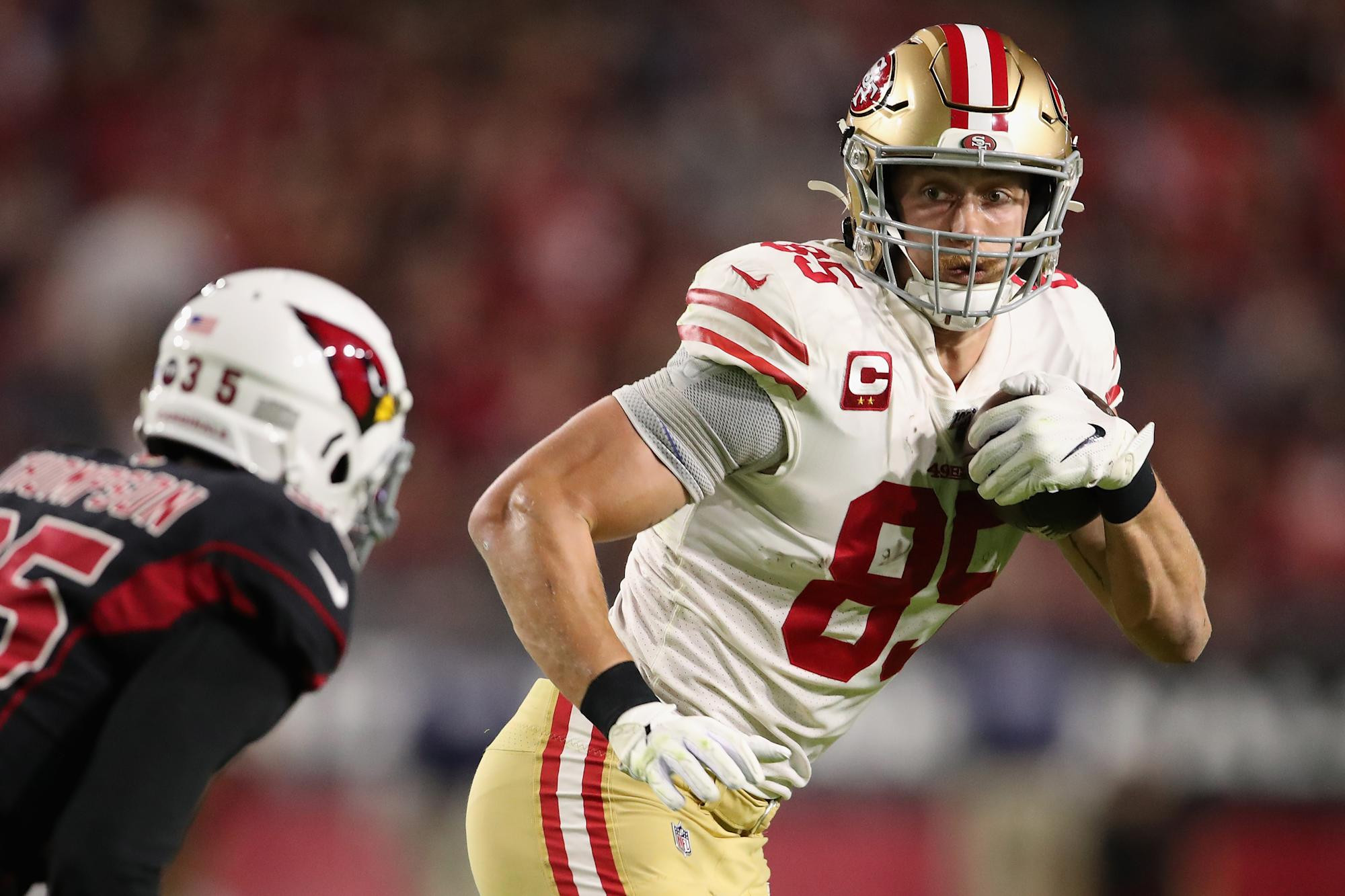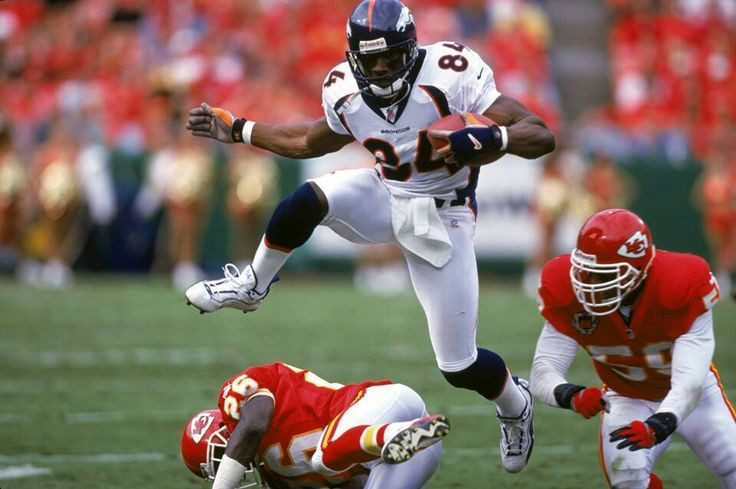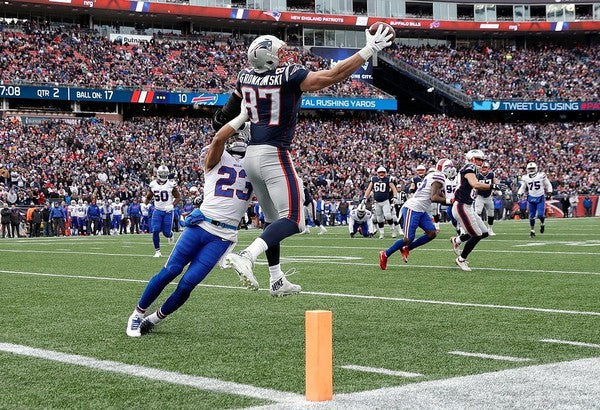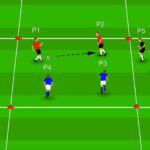Are you curious about the tight end position in football? This guide from CAUHOI2025.UK.COM explains the tight end’s role, required skills, and importance in modern football. Find out why they are such versatile and valuable players.
The tight end (TE) is a vital offensive position in American football, blending the skills of a receiver and a blocker. Let’s delve deeper into what defines a tight end.
1. What Does a Tight End Do in Football?
The tight end is a hybrid position, functioning as both a receiver and a blocker. They line up near the offensive line, providing extra protection for the quarterback and creating running lanes for the running back. In the passing game, they run routes and catch passes.
1.1. Blocking Prowess
Tight ends are often lined up next to offensive linemen, their job includes blocking defensive linemen and linebackers in both the run and pass game. Adaptable athletes are the standard for the position, as teams rely on tight ends to help bolster their rushing attack, and utilize their ability to block big bodies in pass protection.
1.2. Receiving Threat
Tight ends typically run short-to-medium routes, battling linebackers to become available for the quarterback in the middle and underneath areas of the field. Their size and strength make them a great option in the red zone, where teams look to create 1-on-1 matchups.
 George Kittle – Tight End Blocking
George Kittle – Tight End Blocking
George Kittle demonstrating tight end blocking technique.
2. Why is the Position Called “Tight End”?
The name “tight end” is a holdover from football’s early days. Wide receivers were originally called “ends” because they lined up at the end of the offensive line. As the forward pass became more popular, these players started lining up wider, becoming known as “split ends.” The players who stayed closer to the formation and the line of scrimmage were then called “tight ends.”
3. Common Alternate Names for a Tight End
Here are some other ways you might hear the tight end position referred to:
- TE: This is the standard abbreviation.
- H-Back: This refers to a tight end lined up behind the line of scrimmage, outside the offensive tackle. This positioning offers versatility and can create mismatches for the defense.
4. Essential Skills and Physical Attributes of a Tight End
To excel at the tight end position, players need a diverse set of skills and specific physical traits:
4.1. Required Skills
- Strong Hands: Essential for catching passes in traffic.
- Athleticism: Tight ends need to be agile and coordinated.
- Speed: To gain separation from defenders.
- Blocking (Run and Pass): A critical part of their responsibility.
- Route Running: Running precise routes to get open for passes.
- Physicality: To win battles against defenders.
4.2. Ideal Body Type (General Estimates)
- Height: 6’3″ to 6’8″
- Weight: 240 to 270 pounds
- Build: Strong and athletic
At the highest levels, tight ends are comparable to linemen in height but lighter and more athletic.
 Shannon Sharpe – Tight End Stance
Shannon Sharpe – Tight End Stance
Shannon Sharpe in a classic tight end stance.
5. Legendary Tight Ends in NFL History
Here are a few of the best to ever play the position:
- Tony Gonzalez (1997-2013): Gonzalez holds records for receptions and receiving yards by a tight end. He was inducted into the Pro Football Hall of Fame in 2019 and is widely considered one of the greatest tight ends ever.
- Rob Gronkowski (2010-2018, 2020-2021): Known for his incredible athleticism and rapport with quarterback Tom Brady, Gronkowski won four Super Bowl titles.
 Rob Gronkowski – Tight End Catch
Rob Gronkowski – Tight End Catch
Rob Gronkowski making a difficult catch.
- Antonio Gates (2003-2018): A college basketball player turned NFL star, Gates was an eight-time Pro Bowl selection and a consistent receiving threat for the San Diego Chargers.
- Shannon Sharpe (1990-2003): Now a TV personality, Sharpe won four Super Bowl titles and held numerous receiving records for tight ends during his career.
6. Why Are Tight Ends So Important to an Offense?
Versatile players are essential for a successful offense, allowing coaches to expand their play-calling options. Tight ends are crucial because their ability to line up in different spots, run routes, and block diversifies an offense and boosts production. An elite tight end combines the pass-catching skills of a wide receiver with size and strength, creating a mismatch for defenses. They can win with physicality against defensive backs or use athleticism to create separation from linebackers. In short, a top-tier tight end provides offensive coordinators with a reliable weapon that can be used in many ways.
6.1. Versatility Equals Advantage
The tight end’s ability to block and catch makes them incredibly valuable. They can stay in to block on running plays, then slip out and catch a pass on the next play. This versatility keeps defenses guessing and creates opportunities for the offense.
6.2. Mismatch Nightmare
A good tight end can be a nightmare for opposing defenses. They are often too big and strong for defensive backs to cover, but too fast and agile for linebackers. This creates mismatches that offensive coordinators can exploit.
7. The Evolving Role of the Tight End
The tight end position has evolved significantly over the years. In the past, tight ends were primarily blockers. However, in today’s game, they are more involved in the passing game than ever before. This evolution is due to several factors, including the increasing emphasis on passing offenses and the emergence of more athletic tight ends.
7.1. The Modern Passing Game
As offenses have become more pass-heavy, the tight end’s role in the passing game has increased. Tight ends are now expected to run a variety of routes and catch passes in traffic.
7.2. Athleticism at the Position
The tight ends of today are more athletic than ever before. They are bigger, faster, and stronger than their predecessors. This athleticism allows them to be more effective as both blockers and receivers.
8. Tight End Strategies and Plays
Offensive coordinators use a variety of strategies and plays to take advantage of the tight end’s unique skillset.
8.1. Utilizing Mismatches
One common strategy is to create mismatches by lining up the tight end against a smaller defensive back or a slower linebacker. This gives the tight end a better chance of winning the matchup and making a play.
8.2. Play-Action Passing
Tight ends are often used in play-action passing plays. The tight end will initially block, making the defense think it’s a running play. Then, they will release into a route and catch a pass.
8.3. Red Zone Threat
Tight ends are especially valuable in the red zone. Their size and strength make them difficult to cover, and they are often targeted for touchdown passes.
9. The Future of the Tight End Position
The tight end position is likely to continue to evolve in the coming years. As offenses become more creative, tight ends will be asked to do even more. We may see tight ends lining up in the backfield as running backs, or even playing wide receiver.
9.1. Continued Evolution
The tight end position will continue to evolve as offenses adapt to the changing game.
9.2. Versatility is Key
The most successful tight ends will be those who are versatile and can excel as both blockers and receivers.
10. Discover More About Football at CAUHOI2025.UK.COM
At CAUHOI2025.UK.COM, we strive to provide clear and reliable answers to all your football questions. If you’re looking for straightforward explanations and expert insights, our website is your go-to resource.
Are you still trying to wrap your head around all the nuances of football, or maybe you have a burning question about a specific play or rule? Don’t hesitate to visit CAUHOI2025.UK.COM for more in-depth articles and explanations. We’re here to help you become a more informed and engaged football fan.
For more information or if you have specific questions, feel free to contact us.
- Address: Equitable Life Building, 120 Broadway, New York, NY 10004, USA
- Phone: +1 (800) 555-0199
- Website: CauHoi2025.UK.COM
FAQ: Tight End in Football
Here are some frequently asked questions about the tight end position:
1. What is the primary role of a tight end?
The primary role is to be a versatile player who can block and catch passes.
2. What makes a good tight end?
A good tight end possesses strong hands, athleticism, speed, blocking ability, route-running skills, and physicality.
3. How has the tight end position changed over time?
It has evolved from primarily a blocking role to a more significant role in the passing game.
4. What is an H-back?
An H-back is a tight end lined up behind the line of scrimmage, outside the offensive tackle.
5. Why is versatility so important for a tight end?
Versatility allows the offense to be more unpredictable and create mismatches.
6. What is a common strategy for using tight ends in the passing game?
A common strategy is to create mismatches by lining them up against smaller defensive backs or slower linebackers.
7. Why are tight ends valuable in the red zone?
Their size and strength make them difficult to cover, making them a good target for touchdown passes.
8. What are some of the physical requirements for a tight end?
They need to be tall (6’3″ to 6’8″), weigh between 240 and 270 pounds, and have a strong, athletic build.
9. Who are some of the greatest tight ends of all time?
Tony Gonzalez, Rob Gronkowski, Antonio Gates, and Shannon Sharpe are some of the greatest.
10. How do tight ends contribute to the running game?
They provide blocking support for the offensive line, helping to create running lanes for the running back.

